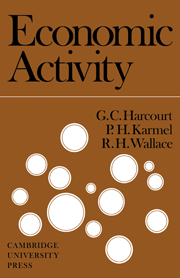Book contents
- Frontmatter
- Preface
- Contents
- 1 INTRODUCTION
- 2 THE NATIONAL ACCOUNTS AND THE INCOME–CREATION PROCESS
- 3 THE PRODUCTION–INCOME–EXPENDITURE CIRCUIT AND NATIONAL ACCOUNTING IDENTITIES
- 4 THE DETERMINATION OF THE EQUILIBRIUM LEVEL OF REAL INCOME
- 5 THE CONCEPT OF FULL EMPLOYMENT
- 6 MONEY IN THE ECONOMIC PROCESS
- 7 THE BANKING SYSTEM AND THE QUANTITY OF MONEY
- 8 THE CONSUMPTION FUNCTION
- 9 THE DETERMINANTS OF INVESTMENT EXPENDITURE
- 10 THE EFFECT OF CHANGES IN EXPENDITURE PLANS: THE MULTIPLIER CONCEPT
- 11 THE GOVERNMENT SECTOR AND THE DETERMINATION OF REAL INCOME
- 12 THE OPEN ECONOMY
- 13 THE INTERACTION BETWEEN PLANNED EXPENDITURES AND FINANCIAL FACTORS
- 14 INFLATION
- 15 ECONOMIC POLICY
- List of suggested reading
- Index
7 - THE BANKING SYSTEM AND THE QUANTITY OF MONEY
Published online by Cambridge University Press: 18 December 2009
- Frontmatter
- Preface
- Contents
- 1 INTRODUCTION
- 2 THE NATIONAL ACCOUNTS AND THE INCOME–CREATION PROCESS
- 3 THE PRODUCTION–INCOME–EXPENDITURE CIRCUIT AND NATIONAL ACCOUNTING IDENTITIES
- 4 THE DETERMINATION OF THE EQUILIBRIUM LEVEL OF REAL INCOME
- 5 THE CONCEPT OF FULL EMPLOYMENT
- 6 MONEY IN THE ECONOMIC PROCESS
- 7 THE BANKING SYSTEM AND THE QUANTITY OF MONEY
- 8 THE CONSUMPTION FUNCTION
- 9 THE DETERMINANTS OF INVESTMENT EXPENDITURE
- 10 THE EFFECT OF CHANGES IN EXPENDITURE PLANS: THE MULTIPLIER CONCEPT
- 11 THE GOVERNMENT SECTOR AND THE DETERMINATION OF REAL INCOME
- 12 THE OPEN ECONOMY
- 13 THE INTERACTION BETWEEN PLANNED EXPENDITURES AND FINANCIAL FACTORS
- 14 INFLATION
- 15 ECONOMIC POLICY
- List of suggested reading
- Index
Summary
People sometimes speak as if the quantity of money is—or directly determines—the level of spending. For example, an increase in economic activity may be attributed to the ‘fact’ that ‘there is more money around’. In chapter 3 it was shown that the aggregate flow of economic activity during a period is measured by the GNP at constant prices, and in other earlier chapters it has been shown that, subject to the upper limit of full employment, the level of activity depends upon the response of businessmen to the level of aggregate planned expenditures.
The argument of the previous chapter was based upon the assumption that the quantity of money was constant. It was explained that, although production and expenditure involve money exchanges, the level of activity can increase without an increase in the quantity of money. Through the capital market funds can be transferred from holders of idle balances to those entities desiring to increase their rates of expenditure. Expenditure plans, however, are formulated in the light of the cost and ease with which finance can be obtained. It was shown that changes in the public's willingness to part with finance will affect the conditions upon which finance is available; and also that, other things being equal, an increase in the rate of expenditure will tend to increase the rate of interest. In this chapter the factors which determine the quantity of money are discussed.
- Type
- Chapter
- Information
- Economic Activity , pp. 88 - 111Publisher: Cambridge University PressPrint publication year: 1967



